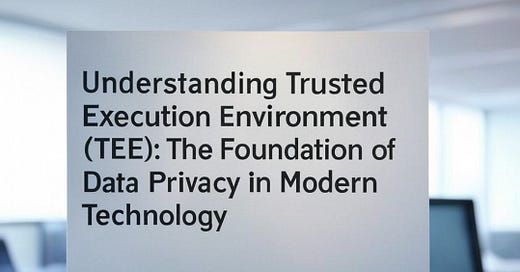Understanding Trusted Execution Environment (TEE): The Foundation of Data Privacy in Modern Technology
Understanding Trusted Execution Environment (TEE): The Foundation of Data Privacy and Security in Modern Computing
In an era where data breaches and cyberattacks are becoming increasingly common, protecting sensitive data has never been more critical. From financial transactions to healthcare records, the need for secure computing environments is driving innovation in data security. At the heart of this innovation is Trusted Execution Environment (TEE) — a groundbreaking technology that ensures the confidentiality and integrity of data and computations.
This article explores what TEE is, how it works, its applications, and its role in advancing privacy-focused technologies, particularly in blockchain and decentralized ecosystems.
What is Trusted Execution Environment (TEE)?
A Trusted Execution Environment (TEE) is a secure, isolated area within a device's processor. It ensures that sensitive data and computations are processed in a trusted environment that is separate from the rest of the system. Unlike the general-purpose operating system, which can be exposed to threats such as malware or unauthorized access, the TEE is designed to resist such attacks, providing a secure space for sensitive operations.
Key Features of TEE:
1. Isolation: The TEE operates independently of the main operating system, ensuring that no unauthorized process can access or alter the data.
2. Confidentiality: Data processed within the TEE remains encrypted and secure, even if the main system is compromised.
3. Integrity: The TEE ensures that computations and data are not tampered with during execution.
4. Verification: It provides cryptographic proof that computations were performed securely.
How TEE Works
TEE leverages hardware-based security to create a trusted environment within the processor. Here’s how it functions step by step:
1. Initialization: The TEE is activated during the device's boot process, creating a separate, secure space in the processor.
2. Data Processing: Sensitive data is loaded into the TEE, where it is decrypted, processed, and re-encrypted before leaving the environment.
3. Access Control: Only authorized applications or processes can interact with the TEE, ensuring no unauthorized access.
4. Attestation: The TEE provides cryptographic evidence of its integrity, allowing external parties to verify that computations were performed securely.
Applications of TEE
The versatility of TEE has made it a cornerstone of security in various industries. Here are some of its key applications:
1. Secure Mobile Payments:
Mobile payment platforms like Google Pay and Apple Pay use TEEs to store and process sensitive financial data, such as credit card information, securely. This prevents unauthorized access, even if the device is compromised.
2. Digital Identity and Authentication:
TEE is used to secure biometric data (e.g., fingerprints, facial recognition) and other sensitive authentication credentials. This enhances security in identity verification processes.
3. Confidential Cloud Computing:
In cloud environments, TEEs enable the secure processing of sensitive data, such as encrypted datasets, without exposing it to the underlying infrastructure.
4. Blockchain and Decentralized Applications:
Blockchain networks, such as Oasis Protocol and Ethereum, are incorporating TEEs to enable confidential smart contracts and private data processing. This enhances privacy in decentralized applications (dApps) while maintaining transparency.
5. Healthcare and Genomics:
TEEs are used to process sensitive medical data and genomic information securely, ensuring compliance with data privacy regulations like HIPAA.
TEE in Blockchain: Revolutionizing Privacy and Security
Blockchain technology is inherently transparent, but this transparency can be a double-edged sword when handling sensitive data. Trusted Execution Environments address this challenge by introducing a layer of privacy to blockchain ecosystems.
Confidential Smart Contracts:
TEEs enable the execution of smart contracts while keeping inputs and outputs confidential. This allows sensitive data, such as financial or medical information, to be processed securely without revealing it to the public blockchain.
Example: Oasis Protocol
Oasis Protocol leverages TEE in its Confidential ParaTime layer, enabling privacy-preserving computations. This ensures that sensitive user data remains protected, making the network suitable for applications in healthcare, finance, and data marketplaces.
Benefits of TEE
Enhanced Security: Protects against a wide range of attacks, including malware, side-channel attacks, and physical tampering.
Data Privacy: Ensures sensitive data remains confidential, even in shared computing environments.
Regulatory Compliance: Helps organizations meet data privacy regulations, such as GDPR, HIPAA, and CCPA.
Trustworthy Computation: Provides cryptographic proof that computations were performed securely and accurately.
Challenges of TEE
Despite its advantages, TEE faces certain challenges:
1. Limited Resources: TEE operates within a constrained environment, which may limit its ability to handle complex computations.
2. Vendor Dependency: TEEs are often proprietary, leading to a reliance on specific hardware manufacturers.
3. Potential Vulnerabilities: While TEEs are highly secure, they are not immune to sophisticated attacks, such as exploits targeting hardware vulnerabilities.
Future of TEE
As technology evolves, the role of TEE in securing digital systems will continue to expand. With advancements in artificial intelligence, IoT, and blockchain, the demand for secure, privacy-preserving computing environments is expected to grow significantly. Innovations such as open-source TEE implementations and integration with decentralized technologies are paving the way for a more secure digital future.
Conclusion
Trusted Execution Environments (TEEs) represent a significant leap forward in the quest for secure and private computing. By isolating sensitive data and computations, TEEs ensure confidentiality and integrity, even in untrusted environments. Whether in mobile payments, cloud computing, or blockchain, TEEs are laying the foundation for a more secure and privacy-focused digital landscape.
As industries increasingly adopt TEE technology, it is clear that this innovation is not just a security feature but a necessity in today’s data-driven world.



